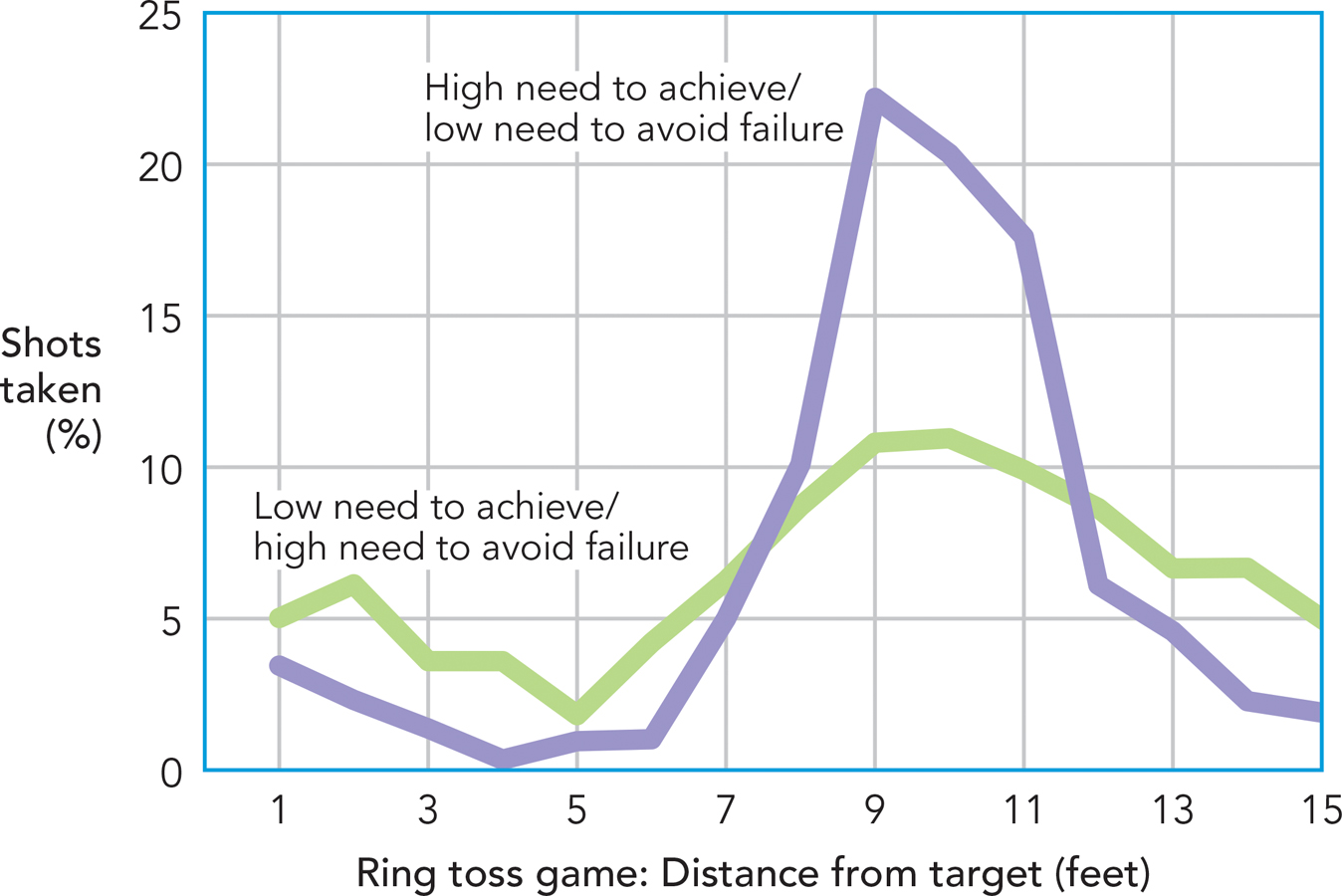11.3 Achievement Needs
Biological needs are compelling; they spur you into action. Other needs are compelling, too. Psychologists have long recognized that a wide variety of needs contribute to human motivation (Murray, 1938). Among these is the need for achievement.
The Need to Achieve
Preview Question
Question
 Is everyone equally motivated to achieve? How can we measure the need for achievement?
Is everyone equally motivated to achieve? How can we measure the need for achievement?
Have you ever put in extra practice to win a competition? Or “pulled an all-
The human need for achievement is evident early in life. Consider young children. In principle, they could sit around passively, just staring into space. But in reality, they are active: knocking over cups, stacking blocks, and looking proud or frustrated as their efforts succeed or fail. Their need to develop skills and mastery over the environment—

The strength of the need for achievement varies from one person to the next. Some people are highly motivated to achieve, whereas others do not give achievement much thought. Researchers measure these individual differences indirectly (McClelland, 1985). In other words, rather than directly asking how motivated you are to achieve, they use tasks that subtly reveal people’s personal motives.
How motivated to achieve are you?
In one commonly used indirect measure, the Thematic Apperception Test (TAT), people tell stories in response to ambiguous pictures (Figure 11.2). The pictures activate achievement needs in some people but not others, and story content reveals these individual differences. For instance, a TAT story filled with characters who strive for success would indicate that the storyteller has a high level of the achievement need. TAT measures of achievement motivation predict motivated behavior and professional success (McClelland, 1987); two meta-

468
WHAT DO YOU KNOW?…
Question 4
xk1NpYM2xOjjWDiimHbL9qvpgzwaburx5ycJ8XfotaauRHWhORqQSNyKM28chK3Ff+A0xMJOdbvu+1/jahdTgp05Qc3lQ50jJlfN7u0GH8jCmBWFjTTdv3i/NIp6s+msgPMgvUeo7YLUVmAMhCUEXPEXHwzQmqSj0gUaxOzbYQFl6ozXMaA+kSojotI+uDPQ1KIon/KFK+r/yTE0aQiVtRGnXE1wkUlSrFyQem8Hb0gV20RdfBrjO9nXfyt/Ppe1gxs2YodTHWBe4lTXZbiKT/cXoElfh3tprSbU0wnJUcS0s/Ygyjef7uKxixqE/zhEnDpnMBSLtd4fpnoUH5Zvr9KVUA+1U2HWlsnvzd4lFdQrVul5zNzUsvcs8Fc=The Need to Avoid Failure
Preview Question
Question
 What kind of person is most likely to seek out challenges?
What kind of person is most likely to seek out challenges?
The need to achieve is not the only motivational force that influences people’s performance. The need to avoid failure is a desire to avoid situations in which you might fail due to a lack of competence. The two needs—
In this study (Atkinson & Litwin, 1960), researchers measured both needs in a population of college students (Figure 11.3). Two groups of students—

Although the game and the instructions were the same for everyone, people approached the task differently. Those high in need for achievement and low in need to avoid failure looked for a challenge: They made most of their throws from the middle distance, where a particularly skillful toss could succeed. The other group—
The point of the study is not, of course, that achievement motives influence choices on games. People often choose among varying amounts of risk, such as when choosing a profession to pursue or deciding how to invest money. Achievement needs may affect behavior on a wide variety of activities in which success requires taking chances and exercising your highest level of skill (McClelland, 1985).
WHAT DO YOU KNOW?…
Question 5
- NkQfClK/xHnTWTyrQyQV+rDjw+rojeqzQWWPKH2QHCymUbdsxQjzU4ekgBNuf0NVmUCkPumZp7zVQw5X7wKqH5Z7iNjAbKA1nklCPp3bJM4zF0Wy7RS2/UUcfLorSx/AxUUyE8pp0ZDaCjq/3KGLFxTeH3F/9Yh86WuxG0HvMbE12S7NuJO3Hu12ell3Y4qK6mWCOYPACPKBvFQH2SCdB5x96ZEFHFo0QiJ+V1YGlfnRfGU5eTpKRKoCq3rsCbdKL/CR6SExyITOqotnnApbT5PL4MNVmnWO
- lSBYjw7NHmXDXmia/yyOfcvXI3uGFwFcCY4KDzZ97MJevotg+z7WBFqYfQPGsmtCrFcXf+5LXFaFd9fIi+Lk9fNQoSzY8uBw33By/VoWl2rp8qC4zLwzrtnH30qLEvZzg6DDrLzBjiGZe6eD0PDq97YoJhOWZVKKhn4wH5EbsV2ZtcZCzFyXjHMOF0gUlmTk5ALXHR2237UU+XEmRry45W9TnqQNANgQgGOqQA==
a. It is not very challenging to get the ring on the peg from very close distance. From a far distance, the challenge is so great that it ironically ceases to be challenging, because no one expects the ring-tosser to succeed. b. The middle distance is considered challenging because it is not too easy but also not so difficult as to be impossible to succeed.